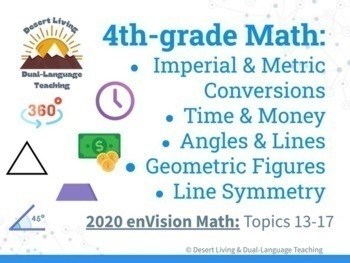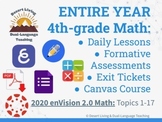4th grade 2020 enVision Daily Math Lessons: Angles Time Money Geometry Symmetry
Desert Living and Dual-Language Teaching
86 Followers
Grade Levels
3rd - 5th, Homeschool
Subjects
Resource Type
Standards
CCSS4.MD.A.1
CCSS4.MD.A.2
CCSS4.MD.A.3
CCSS4.MD.B.4
CCSS4.MD.C.5
Formats Included
- Google Slides™
Pages
15 pages
Desert Living and Dual-Language Teaching
86 Followers

Made for Google Drive™
This resource can be used by students on Google Drive or Google Classroom. To access this resource, you’ll need to allow TPT to add it to your Google Drive. See our FAQ and Privacy Policy for more information.
Also included in
- EVERYTHING you need to run a 21st-century classroom for 4th-grade math! Includes resources for whole-group instruction, small group, independent practice, and blended learning. Video Preview LinkThis resource includes:DAILY LESSONS compatible with Notability or Explain Everything for all Savvas enViPrice $75.00Original Price $100.00Save $25.00
Description
EVERYTHING you need to run a 21st-century classroom for 4th-grade math! Includes resources for whole-group instruction, small group, independent practice, and blended learning.
This resource includes:
- DAILY LESSONS compatible with Notability or Explain Everything for all Savvas enVision 2020 math lessons between Topics 13-17.
- BLENDED LEARNING lessons that give students the ability to work ahead at their own pace through videos, guided practice, and independent practice.
- LEARNING INTENTIONS for every lesson.
- PRE-MADE CANVAS COURSE to support blended learning or independent / small group practice.
- WEEKLY QUIZZES for formative assessment of standards following the enVision curriculum map.
- EXIT TICKETS for authentic student feedback.
- HOW-TO VIDEOS on how to import, download, and edit all files.
Math Topics and Concepts included in End of Year (April - June)
- Measurement: Find Equivalence in Units of Measure
- Algebra: Generate and Analyze Patterns
- Geometric Measurement: Understand Concepts of Angles and Angle Measurement
- Lines, Angles, and Shapes
- Step Up to 5th Grade
Weekly Quizzes
If you are not in need of the comprehensive curriculum and resources included in this product and instead would like to only purchase the Weekly Quizzes Formative Assessment Google Forms product, click here.
**Disclaimer: These are daily lessons and materials to use with your students and facilitate both in-person and blended learning - not lesson plans to turn into your administration.**
Total Pages
15 pages
Answer Key
N/A
Teaching Duration
N/A
Last updated Nov 28th, 2021
Report this resource to TPT
Reported resources will be reviewed by our team. Report this resource to let us know if this resource violates TPT’s content guidelines.
Standards
to see state-specific standards (only available in the US).
CCSS4.MD.A.1
Know relative sizes of measurement units within one system of units including km, m, cm; kg, g; lb, oz.; l, ml; hr, min, sec. Within a single system of measurement, express measurements in a larger unit in terms of a smaller unit. Record measurement equivalents in a two-column table. For example, know that 1 ft is 12 times as long as 1 in. Express the length of a 4 ft snake as 48 in. Generate a conversion table for feet and inches listing the number pairs (1, 12), (2, 24), (3, 36),...
CCSS4.MD.A.2
Use the four operations to solve word problems involving distances, intervals of time, liquid volumes, masses of objects, and money, including problems involving simple fractions or decimals, and problems that require expressing measurements given in a larger unit in terms of a smaller unit. Represent measurement quantities using diagrams such as number line diagrams that feature a measurement scale.
CCSS4.MD.A.3
Apply the area and perimeter formulas for rectangles in real world and mathematical problems. For example, find the width of a rectangular room given the area of the flooring and the length, by viewing the area formula as a multiplication equation with an unknown factor.
CCSS4.MD.B.4
Make a line plot to display a data set of measurements in fractions of a unit (1/2, 1/4, 1/8). Solve problems involving addition and subtraction of fractions by using information presented in line plots. For example, from a line plot find and interpret the difference in length between the longest and shortest specimens in an insect collection.
CCSS4.MD.C.5
Recognize angles as geometric shapes that are formed wherever two rays share a common endpoint, and understand concepts of angle measurement:






